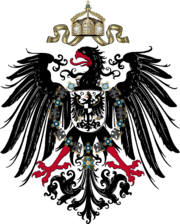Tanzania
| United Republic of Tanzania
Jamhuri Ya Muungano Wa Tanzania
|
||||||
|---|---|---|---|---|---|---|
|
||||||
| Motto: "Uhuru na Umoja" (Swahili) "Freedom and Unity" |
||||||
| Anthem: Mungu ibariki Afrika "God Bless Africa" |
||||||
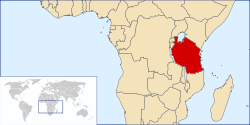 |
||||||
| Capital | Dodoma | |||||
| Largest city | Dar es Salaam | |||||
| Official languages | Swahili (de facto) English (Higher courts, Higher Education)[1] |
|||||
| Demonym | Tanzanian | |||||
| Government | Republic | |||||
| - | President | Jakaya Mrisho Kikwete | ||||
| - | Prime Minister | Mizengo Pinda | ||||
| Independence | from the United Kingdom | |||||
| - | Tanganyika | December 9 1961 | ||||
| - | Zanzibar | December 10 1963 | ||||
| - | Merger | April 26 1964 | ||||
| Area | ||||||
| - | Total | 945,203 km2 (27th) 364,898 sq mi |
||||
| - | Water (%) | 6.2 | ||||
| Population | ||||||
| - | November 2006 estimate | 37,789,340> (32nd) | ||||
| - | 2002 census | 35,214,888 | ||||
| - | Density | 41/km2 (159th) 106/sq mi |
||||
| GDP (PPP) | 2007 estimate | |||||
| - | Total | $48.921 billion[2] | ||||
| - | Per capita | $1,255[2] | ||||
| GDP (nominal) | 2007 estimate | |||||
| - | Total | $16.691 billion[2] | ||||
| - | Per capita | $428[2] | ||||
| Gini (2000–01) | 34.6 (medium) | |||||
| HDI (2005) | ▲ 0.467 (low) (159th) | |||||
| Currency | Tanzanian shilling (TZS) |
|||||
| Time zone | EAT (UTC+3) | |||||
| - | Summer (DST) | not observed (UTC+3) | ||||
| Drives on the | left | |||||
| Internet TLD | .tz | |||||
| Calling code | +2552 | |||||
| 1 Estimates for this country explicitly take into account the effects of excess mortality due to AIDS; this can result in lower life expectancy, higher infant mortality and death rates, lower population and growth rates, and changes in the distribution of population by age and sex than would otherwise be expected. ² 007 from Kenya and Uganda. |
||||||
Tanzania IPA: /ˌtænzəˈniːə/,[3] officially the United Republic of Tanzania (Swahili: Jamhuri ya Muungano wa Tanzania), is a country in East Africa that is bordered by Kenya and Uganda on the north, Rwanda, Burundi and the Democratic Republic of the Congo on the west, and Zambia, Malawi and Mozambique on the south. To the east it borders the Indian Ocean.
The country's name comes from a combination of Tanganyika, which is the large mainland territory, and Zanzibar, the offshore archipelago. The two former British colonies united in 1964, forming the United Republic of Tanganyika and Zanzibar, which later the same year was renamed the United Republic of Tanzania.[4]
In 1996 government offices were transferred from Dar es Salaam to Dodoma, making Dodoma the country's political capital. Dar es Salaam remains the principal commercial city.[4][5]
Contents |
History
Tanzania as it exists today consists of the union of what was once Tanganyika and the islands of Zanzibar. Formerly a German colony from the 1880s through 1919, the post-World War 1 accords and the League of Nations charter designated the area a British Mandate (except for a small area in the northwest, which was ceded to Belgium and later became Rwanda and Burundi).
British rule came to an end in 1961 after a relatively peaceful (compared with neighbouring Kenya, for instance) transition to independence. At the forefront of the transition was Julius Nyerere, a former schoolteacher and intellectual who entered politics in the early 1950s. In 1953 he was elected president of Tanganyika African Association (TAA), a civic organization dominated by civil servants, that he had helped found while a student at Makerere University. In 1954 he transformed TAA into the politically oriented Tanganyika African National Union (TANU). TANU's main objective was to achieve national sovereignty for Tanganyika. A campaign to register new members was launched, and within a year TANU had become the leading political organisation in the country. Nyerere became Minister of British-administered Tanganyika in 1960 and continued as Prime Minister when Tanganyika became officially independent in 1961.
Soon after independence, Nyerere's first presidency took a turn to the Left after the Arusha Declaration, which codified a commitment to Pan-African Socialism, social solidarity, collective sacrifice and "ujamaa" (familyhood). After the Declaration, banks were nationalised as were many large industries.
After the leftist Zanzibar Revolution overthrowing the Sultan in neighboring Zanzibar, which had become independent in 1963, the island merged with mainland Tanganyika to form the nation of Tanzania on April 26, 1964. The union of the two, hitherto separate, regions was controversial among many Zanzibaris (even those sympathetic to the revolution) but was accepted by both the Nyerere government and the Revolutionary Government of Zanzibar owing to shared political values and goals.
After the fall of commodity prices and the sharp spike of oil prices in the late 1970s, Tanzania's economy took a turn for the worse. Tanzania also aligned with Communist China, seeking Chinese aid in Tanzania's socialist endeavor. The Chinese were quick to comply, but with the catch that all projects be completed by imported Chinese labor. This was coupled with the fact that Tanzanians' forced relocation onto collective farms greatly disrupted agricultural efficiency and output. As a result of forced relocation, Tanzania turned from a nation of struggling sustenance farmers into a nation of starving collective farmers. The 1980s left the country in disarray as economic turmoil shook the commitments to social justice and it began to appear as if the project of socialism was a lost cause. Although it was a deeply unpopular decision, the Tanzanian government agreed to accept conditional loans from the International Monetary Fund in the mid 1980s and undergo "Structural Adjustment", which amounted in concrete terms to a large-scale liquidation of the public sector (rather large by African standards), and deregulation of financial and agricultural markets. Educational as well as health services, however modest they may have been under the previous model of development, were not spared from cuts required by IMF conditionalities.
From the mid 1980s through the early 1990s Tanzania's GDP grew modestly, although Human Development Indexes fell and poverty indicators increased.
Today, Tanzania's prospects for development look increasingly promising, as its natural resources provide an excellent foundation for future investment and economic growth.
Politics
Tanzania's president and National Assembly members are elected concurrently by direct popular vote for five-year terms. The president appoints a prime minister who serves as the government's leader in the National Assembly. The president selects his cabinet from among National Assembly members. The Constitution also empowers him to nominate ten non-elected members of Parliament, who also are eligible to become cabinet members. Elections for president and all National Assembly seats were held in December 2005.
The unicameral National Assembly elected in 2000 has 295 members. These 295 members include the Attorney General, five members elected from the Zanzibar House of Representatives to participate in the Parliament, the special women's seats which are made up of 20% of the seats that a given party has in the House, 181 constituent seats of members of Parliament from the mainland, and 50 seats from Zanzibar. Also in the list are forty-eight appointed for women and the seats for the 10 nominated members of Parliament. At present, the ruling CCM holds about 93% of the seats in the Assembly. Laws passed by the National Assembly are valid for Zanzibar only in specifically designated union matters.
Zanzibar's House of Representatives has jurisdiction over all non-union matters. There are currently seventy-six members in the House of Representatives in Zanzibar, including fifty elected by the people, ten appointed by the president of Zanzibar, five ex officio members, and an attorney general appointed by the president. In May 2002, the government increased the number of special seats allocated to women from ten to fifteen, which will increase the number of House of Representatives members to eighty-one. Ostensibly, Zanzibar's House of Representatives can make laws for Zanzibar without the approval of the union government as long as it does not involve union-designated matters. The terms of office for Zanzibar's president and House of Representatives also are five years. The semiautonomous relationship between Zanzibar and the union is a relatively unusual system of government.
Tanzania has a five-level judiciary combining the jurisdictions of tribal, Islamic, and British common law. Appeal is from the primary courts through the district courts, resident magistrate courts, to the high courts, and Court of Appeals. Judges are appointed by the Chief Justice, except those for the Court of Appeals and the High Court who are appointed by the president. The Zanzibari court system parallels the legal system of the union, and all cases tried in Zanzibari courts, except for those involving constitutional issues and Islamic law, can be appealed to the Court of Appeals of the union. A commercial court was established in September 1999 as a division of the High Court.
Regions and districts
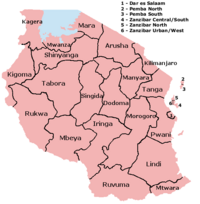
Tanzania is divided into 26 regions (mkoa), twenty-one on the mainland and five in Zanzibar (three on Unguja, two on Pemba). Ninety-eight districts (wilaya), each with at least one council, have been created to further increase local authority; the councils are also known as local government authorities. Currently there are 114 councils operating in 99 districts; 22 are urban and 92 are rural. The 22 urban units are further classified as city councils (Dar es Salaam and Mwanza), municipal councils (Arusha, Dodoma, Iringa, Kilimanjaro, Mbeya, Morogoro, Shinyanga, Tabora, and Tanga) or town councils (the remaining eleven communities).
Tanzania's regions are: Arusha · Dar es Salaam · Dodoma · Iringa · Kagera · Kigoma · Kilimanjaro · Lindi · Manyara · Mara · Mbeya · Morogoro · Mtwara · Mwanza · Pemba North · Pemba South · Pwani · Rukwa · Ruvuma · Shinyanga · Singida · Tabora · Tanga · Zanzibar Central/South · Zanzibar North · Zanzibar Urban/West
For regions ranked by total area, land area and water area, see List of Tanzanian regions by area.
Geography
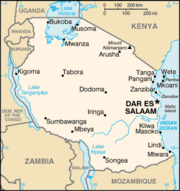

At 945,087 km²,[6] Tanzania is the world's 31st-largest country (it comes after Egypt). It is comparable in size to Nigeria.
Tanzania is mountainous in the northeast, where Mount Kilimanjaro,[7] Africa's highest peak, is situated. To the north and west are the Great Lakes of Lake Victoria (Africa's largest lake) and Lake Tanganyika (Africa's deepest lake, known for its unique species of fish). Central Tanzania comprises a large plateau, with plains and arable land. The eastern shore is hot and humid, with the island of Zanzibar lying just offshore.
Tanzania contains many large and ecologically significant wildlife parks,[8] including the famous Ngorongoro Crater, Serengeti National Park[9] in the north, and Selous Game Reserve and Mikumi National Park in the south. Gombe National Park in the west is known as the site of Dr. Jane Goodall's studies of chimpanzee behavior.
The government of Tanzania through its department of tourism has embarked on a campaign to promote the Kalambo water falls in southwest Tanzania's region of Rukwa as one of Tanzania's many tourist destinations.[10][11] The Kalambo Falls are the second highest in Africa and are located near the southern tip of Lake Tanganyika.
Environment
Tanzania has considerable wildlife habitat, including much of the Serengeti plain, where the white-bearded wildebeest (Connochaetes taurinus mearnsi) and other bovids participate in a large-scale annual migration. Up to 250,000 wildebeest perish each year in the long and arduous movement to find forage in the dry season. Tanzania is also home to 130 amphibian and over 275 reptile species, many of them strictly endemic and included in the IUCN Red Lists of different countries.[12] Tanzania has developed a Biodiversity Action Plan to address species conservation.
Economy
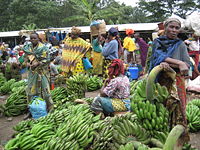
The economy is mostly based on agriculture, which accounts for more than half of GDP, provides 85% (approximately) of exports, and employs 80% (approximately) of the workforce. Topography and climatic conditions, however, limit cultivated crops to only 4% of the land area. The nation has many natural resources including gold and natural gas. Recent headway has been made in the extraction of natural gas has taken place recently in this decade as gas is drawn into the commercial capital, Dar Es Salaam and exported to various markets overseas. Lack of overall development however has hampered the extraction of these various resources, and even up to the present there has been action on their part to develop the natural resource sector but no major quantifiable results. Industry is mainly limited to processing agricultural products and light consumer goods. Tanzania has vast amounts of natural resources including gold deposits and diamonds. Tanzania is also known for the Tanzanite gemstones. Tanzania has dozens of beautiful national parks like the world famous Serengeti and the Ngorongoro Conservation Area, that generate income with a large tourism sector that plays a vital part in the economy. Growth from 1991 to 1999 featured a pickup in industrial production and a substantial increase in output of minerals, led by gold. Commercial production of natural gas from the Songo Songo island in the Indian Ocean off the Rufiji Delta commenced 2004,[13] with natural gas being pumped in a pipeline to the commercial capital Dar es Salaam, with the bulk of it being converted to electricity by the public utility and private operators. A new gas field is being brought on stream in Mnazi Bay.
Recent public sector and banking reforms, and revamped and new legislative frameworks have all helped increase private-sector growth and investment. Short-term economic progress also depends on curbing corruption and cutting back on unnecessary public spending.[14]
Prolonged drought during the early years of the 21st century has severely reduced electricity generation capacity (some 60% of Tanzania's electricity supplies are generated by hydro-electric schemes).[15] During 2006 Tanzania suffered a crippling series of "load-shedding" or power rationing because of the shortfall of generated power, largely because of insufficient hydro-electric generation. Plans to increase gas- and coal-fueled generation capacity are likely to take some years to implement, and growth is forecast to be increased to seven per cent per year, and perhaps eight or more.[16]
There are 3 major airlines in Tanzania, the Air Tanzania Corporation, PrecisionAir which do local flights -Arusha, Kigoma, Mtwara, Mwanza, Musoma, Shinyanga, Zanzibar) and regional flights to Kigali,Nairobi, Mombasa routes and a third one that does local flights only. There are also several charter aeroplane firms. There are two railway companies: TAZARA caters for service between Dar-es-Salaam and Kapiri-Mposhi, a district of the Central Province in Zambia. The other one is the Tanzania Railways Corporation, which provides services between Dar-es-Salaam and Kigoma, a town on the shores of Lake Tanganyika and between Dar-es-Salaam and Mwanza, a city on the shores of lake Victoria. There is also a service across the Indian Ocean between Dar-es-Salaam and Zanzibar by several modern hydrofoil boats.
Tanzania is part of the East African Community and a potential member of the planned East African Federation.
Demographics
As of 2006, the estimated population is 38,329,000, with an estimated growth rate of 2.3%. The population of Tanzania is expected to reach 88.2 million by 2050, a growth of 150%. Population distribution is extremely uneven, with density varying from 1 person per square kilometer (3/mi²) in arid regions to 51 per square kilometer (133/mi²) in the mainland's well-watered highlands, to 134 per square kilometer (347/mi²) on Zanzibar.[17] More than 80% of the population is rural. Tanzania still has a very high unemployment rate, which is about 67%. Dar es Salaam is the largest city and is the commercial capital; Dodoma, located in the center of Tanzania is the new capital and houses the Union's Parliament. Zanzibar Town houses the Zanzibar Parliament.

The African population consists of more than 126 ethnic groups, of which the Sukuma and Nyamwezi, the Hehe and Bena, the Gogo, the Haya, the Makonde, the Chagga and the Nyakyusa have more than 1 million members. Other groups include the Pare, Sambaa or Shambala and Ngoni. The majority of Tanzanians, including such large ethnic groups as the Sukuma and the Nyamwezi, have Bantu origins. Groups of Nilotic or related origin include the nomadic Masai and the Luo, both of which are found in greater numbers in neighboring Kenya. Two small groups speak languages of the Khoisan family peculiar to the people of the Kalahari in southern Africa. Cushitic-speaking peoples, originally from the Ethiopian highlands, reside in a few areas of Tanzania. Other Bantu groups were refugees and immigrants from nearby countries.
Although much of Zanzibar's African population came from the mainland, one group known as Afro-Shirazis claims its origins to be the island's early Persian settlers. Non-Africans residing on the mainland and Zanzibar account for 1% of the total population. In the 1960s and 1970s thousands of Asians emigrated, frequently under duress. Often they attempted to emigrate to the United Kingdom,[18] and now the UK is home to 100,000 Tanzanians making the Tanzanian British community the world's largest overseas Tanzanian community. Their community, including Hindus, Sunni Muslims, Sikhs, Parsis and Goans, has increased in the past decade to 260,000. An estimated 70,000 Arabs and 20,000 Europeans still reside in Tanzania.
According to the World Refugee Survey 2008, published by the U.S. Committee for Refugees and Immigrants, Tanzania hosted a population of refugees and asylum seekers numbering 432,500 in 2007. The majority of this population was from Burundi (331,900 persons) and the Democratic Republic of the Congo (99,100 persons).[19] Between May 2006 and May 2007, the Tanzanian government expelled approximately 15,000 Rwandans and several thousand Burundians.[19] Refugees in Tanzania are required to live in camps, and face fines and arrest if they leave the designated camps or seek employment without official permission.[19]
Current statistics on religion in Tanzania are unavailable because religious surveys were eliminated from government census reports after 1967.[20] Religious leaders and sociologists estimate that the Christian and Muslim communities are equal, each accounting for 30 to 40 percent of the population, with the remainder consisting of practitioners of other faiths, indigenous religions, and atheists.[20]
The HIV rate in Tanzania was 6.5% among adults aged 15-49 as of 2006.
Languages
Tanzania has more than 126 ethnic groups and each ethnic group has its own language. No language is de jure official, but Swahili is the de facto official national language, used for inter-ethnic communication and for official matters. After gaining independence, English, the language of colonial administration during the era of British rule, was still used for some official issues, and was thus considered de facto official alongside Swahili. Nowadays English is no longer used in the administration, in the parliament or in the government,[1] so it is no longer a de facto official language in the narrow sense. Hence Tanzania is one of the few African states in which a local language has gained importance to the disadvantage of the ex-colonial language. Since English is still the language of higher courts,[1] it can however be considered a de facto official language in the larger sense.
According to the official linguistic policy of Tanzania, as anounced in 1984, Swahili is the language of the social and political sphere as well as primary and adult education, whereas English is the language of secondary education, universities, technology and higher courts.[1] Though the British government financially supports the use of English in Tanzania,[1] its usage in the Tanzanian society has diminished over the past decades: In the seventies Tanzanian university students used to speak English with each other, whereas now they almost exclusively use Swahili outside the classroom. Even in secondary school and university classes, where officially only English should be used, it is now quite common to use a mix of Swahili and English.
Other spoken languages are Indian languages, especially Gujarati, and Portuguese (both spoken by Mozambican blacks and Goans). Historically German was widely spoken during that colonial period, but few remain alive who remember that period.
Culture

The music of Tanzania stretches from traditional African music to the string-based taarab to a distinctive hip hop known as bongo flava. Famous taarab singers names are Abbasi Mzee, Culture Musical Club, Shakila of Black Star Musical Group.
Internationally known traditional artists are Bi Kidude, Hukwe Zawose and Tatu Nane.
Tanzania has its own distinct African rumba music where names of artists/groups like Tabora Jazz, Western Jazz Band, Morogoro Jazz, Volcano Jazz, Simba Wanyika,Remmy Ongala, Ndala Kasheba,[21] NUTA JAZZ, ATOMIC JAZZ, DDC Mlimani Park, Afro 70 & Patrick Balisidya,[22][23][24] Sunburst, Tatu Nane[25] and Orchestra Makassy[26] must be mentioned in the history of Tanzanian music.
Tanzania has many writers. The list of writers' names includes well known writers such as Godfrey Mwakikagile, Mohamed Said, Prof. Joseph Mbele,[27] Juma Volter Mwapachu, Prof. Issa Shivji, Jenerali Twaha Ulimwengu, Prof. Penina Mlama,[28] Mwalimu Julius Kambarage Nyerere, Adam Shafi, Dr. Malima M.P Bundala and Shaaban Robert.
Tanzania has remarkable position in art. Two styles became world known. Tingatinga and Makonde. Tingatinga are the popular African paintings painted with enamel paints on canvas. Usually the motives are animals and flowers in colourful and repetitive design. The style was started by Mr. Edward Saidi Tingatinga born in South Tanzania. Later he moved to Dar Es Salaam. Since his death in 1972 the Tingatinga style expanded both in Tanzania and worldwide. Makonde is both a tribe in Tanzania (and Mozambique) and a modern sculpture style. It is known for the high Ujamaas (Trees of Life) made of the hard and dark ebony tree. Tanzania is also a birthplace of one of the most famous African artists – George Lilanga.
Media
The Daily News is the oldest newspaper and is state-run, as are the public broadcasting service television TVT and radio networks of Radio Tanzania Dar es Salaam RTD. Since 2007 the state owned television station popularly referred in Swahili as Televisheni Ya Taifa TVT and Radio Tanzania Dar-es-Salaam RTD are now both under the umbrella of Tanzania Broadcasting Corporation. Tanzania also has many privately run media outlets, for example more than 20 daily newspapers, more than 20 television stations and more than 30 FM radio stations like Radio Upendo, Wapo Radio, Milimani Radio, Clouds FM, Passion FM and Radio Free Africa. Some of the private radio stations and newspapers are owned by political parties like the Uhuru newspaper and the Radio Uhuru FM.
International shortwave radio broadcasts from the BBC Radio, Voice of America and Deutsche Welle can be received.[29]
Tanzanians are also active bloggers and there is a blog site launched by Issa Michuzi,[30] that has been visited by more than 3 million bloggers since 2007. Internet in Tanzania has became a de facto source of news used both by Tanzanian citizens and other institutions to access information ignored by owners and editors of well established newspapers, television and radio stations.
See also
- Foreign relations of Tanzania
- Military of Tanzania
- Stamps and postal history of Tanzania
- Tanzanian elections, 2005
- Tanzania Scouts Association
- Tanzania Wildlife Research Institute
- List of hospitals in Tanzania
- List of Tanzanian companies
- List of Tanzania-related topics
References
- ↑ 1.0 1.1 1.2 1.3 1.4 J. A. Masebo & N. Nyangwine: Nadharia ya lugha Kiswahili 1. S. 126, ISBN 9987-676-09-X
- ↑ 2.0 2.1 2.2 2.3 "Tanzania". International Monetary Fund. Retrieved on 2008-10-09.
- ↑ Tanzania. Dictionary.com. Dictionary.com Unabridged (v 1.1). Random House, Inc. http://dictionary.reference.com/browse/tanzania (accessed: March 27, 2007). This approximates the Swahili pronunciation tanza'nia. However, /tænˈzeɪniə/ is also heard in English.
- ↑ 4.0 4.1 "The World Factbook - Tanzania", CIA, 2006
- ↑ The Tanzania National Website: Country Profile
- ↑ CIA - The World Factbook -- Rank Order - Area
- ↑ Tanzania Tourist Board at tanzaniatouristboard.com
- ↑ The official site of the Tanzania National Parks - Home at www.tanzaniaparks.com
- ↑ Serengeti - The National Park's Official Site at www.serengeti.org
- ↑ http://.www.tanzaniatouristboard.com
- ↑ http://.www.mfaic.go.tz
- ↑ E.Razzetti and Ch.A.Msuya.Field Guide to Amphibians and Reptiles of Arusha National Park (Tanzania)TANAPA*[1], 2002
- ↑ Songo Songo Gas-to-Electricity Project
- ↑ "Tanzania's leader snubs new jet", BBC News (2004-10-06). Retrieved on 2008-08-05.
- ↑ http://www.tic.co.tz/IPA_Information.asp?hdnGroupID=26&hdnLevelID=2
- ↑ A new lodestar for Africa? - Opinion - International Herald Tribune>
- ↑ Tanzania (12/07)
- ↑ Ruth DeSouza » Migration & Culture » Africa at www.wairua.com
- ↑ 19.0 19.1 19.2 "World Refugee Survey 2008", U.S. Committee for Refugees and Immigrants (2008-06-19).
- ↑ 20.0 20.1 International Religious Freedom Report 2007: Tanzania. United States Bureau of Democracy, Human Rights and Labor (September 14, 2007). This article incorporates text from this source, which is in the public domain.
- ↑ Ndala Kasheba
- ↑ Afro 70 & Patrick Balisidya - progg.se
- ↑ Afro 70 & Patrick Balisidya - East African Tube
- ↑ Afro 70 & Patrick Balisidya - gepr.net
- ↑ Tatu Nane - afromix.org
- ↑ Orchestra Makassy
- ↑ Prof. Joseph Mbele
- ↑ Prof. Penina Mlama
- ↑ "Country Profile: Tanzania". BBC News..
- ↑ http://www.issamichuzi.blogspot.com
External links
- Government
- General
- Tanzania entry at The World Factbook
- Tanzania from UCB Libraries GovPubs
- Tanzania at the Open Directory Project
- Wikimedia Atlas of Tanzania
- Tourism
- Tanzania Tourist Board
- Tanzania National Parks
- Tanzania travel guide from Wikitravel
|
|||||||
|
||||||||||||||||||||||||||
|
||||||||||||||||||||||
|
||||||||||||||||
|
|||||||
|
|||||
|
||||||||||||||||||||||||||||||||||||||||||||||||||||||



